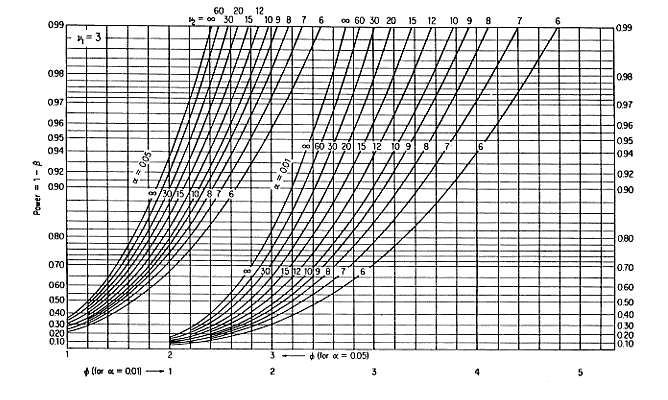

A General Statement
Power
| Truth | ||
| Experimenter's Decision | H0 is true | H0 is false |
| Fail to reject H0 | Correct Decision 1 - α | Type II Error β |
| Reject H0 | Type I Error α | Correct Decision 1 - β Power |
Factors that Effect Power
Effect Size
The effect size coefficient, f, expresses the differences among the group means in terms of standard units.

f = .10 -- small effect size f = .25 -- medium effectg size f = .40 -- large effect sizeAn estimate of the effect size, f, can be obtained using ω2

use http://www.philender.com/courses/data/cr4new, clear
anova y a
Number of obs = 32 R-squared = 0.4455
Root MSE = 1.476 Adj R-squared = 0.3860
Source | Partial SS df MS F Prob > F
-----------+----------------------------------------------------
Model | 49.00 3 16.3333333 7.50 0.0008
|
a | 49.00 3 16.3333333 7.50 0.0008
|
Residual | 61.00 28 2.17857143
-----------+----------------------------------------------------
Total | 110.00 31 3.5483871
effectsize a
anova effect size for a with dep var = y
total variance accounted for
omega2 = .37854187
eta2 = .44545455
Cohen's f = .78046067
partial variance accounted for
partial omega2 = .37854187
partial eta2 = .44545455
use http://www.philender.com/courses/data/hsb2
anova write prog
Number of obs = 200 R-squared = 0.1776
Root MSE = 8.63918 Adj R-squared = 0.1693
Source | Partial SS df MS F Prob > F
-----------+----------------------------------------------------
Model | 3175.69786 2 1587.84893 21.27 0.0000
|
prog | 3175.69786 2 1587.84893 21.27 0.0000
|
Residual | 14703.1771 197 74.635417
-----------+----------------------------------------------------
Total | 17878.875 199 89.843593
effectsize prog
anova effect size for prog with dep var = write
total variance accounted for
omega2 = .16857021
eta2 = .17762291
Cohen's f = .45027478
partial variance accounted for
partial omega2 = .16857021
partial eta2 = .17762291
Practicalities
Using Pearson-Hartley Power Curves
Example
| Example | 1 | 2 |
| alpha | .01 | .05 |
| power | .80 | .80 |
| ν1 | 3 | 3 |
| φ | 2.2 | 2.2 |
| Read ν2 | 30 | 7 |
| n per cell* | 8 | 3 |
Power Curve for ν1 = 3

Using Monte Carlo Simulation
Next, we will do a Monte Carlo power simulation using the simpower command from ATS. Here is how to get the program.
net from http://www.ats.ucla.edu/stat/stata/ado/analysis/
net install simpower
Let's try simulating a three group anova.
simpower, groups(3) n(5 5 5) mu(10 12 14) s(3 3 3) Sample Sizes, Means and Standard Deviations ------------------------------------------- N1 = 5 MU1 = 10 S1 = 3 N2 = 5 MU2 = 12 S2 = 3 N3 = 5 MU3 = 14 S3 = 3 1000 simulated ANOVA F tests ------------------------------ Alpha Simulated Level Power ------------------------------ 0.1000 0.5260 0.0750 0.4680 0.0500 0.3820 0.0250 0.2600 0.0100 0.1440 simpower, groups(3) n(10 10 10) mu(10 12 14) s(3 3 3) Sample Sizes, Means and Standard Deviations ------------------------------------------- N1 = 10 MU1 = 10 S1 = 3 N2 = 10 MU2 = 12 S2 = 3 N3 = 10 MU3 = 14 S3 = 3 1000 simulated ANOVA F tests ------------------------------ Alpha Simulated Level Power ------------------------------ 0.1000 0.8330 0.0750 0.7800 0.0500 0.7110 0.0250 0.5900 0.0100 0.4440 simpower, groups(3) n(15 15 15) mu(10 12 14) s(3 3 3) Sample Sizes, Means and Standard Deviations ------------------------------------------- N1 = 15 MU1 = 10 S1 = 3 N2 = 15 MU2 = 12 S2 = 3 N3 = 15 MU3 = 14 S3 = 3 1000 simulated ANOVA F tests ------------------------------ Alpha Simulated Level Power ------------------------------ 0.1000 0.9400 0.0750 0.9280 0.0500 0.9050 0.0250 0.8350 0.0100 0.7160
Next, we will use simpower beginning with a real anova.
use http://www.gseis.ucla.edu/courses/data/crf33
anova y b
Number of obs = 45 R-squared = 0.2957
Root MSE = 9.35626 Adj R-squared = 0.2621
Source | Partial SS df MS F Prob > F
-----------+----------------------------------------------------
Model | 1543.33333 2 771.666667 8.82 0.0006
|
b | 1543.33333 2 771.666667 8.82 0.0006
|
Residual | 3676.66667 42 87.5396825
-----------+----------------------------------------------------
Total | 5220.00 44 118.636364
simpower y b
Sample Sizes, Means and Standard Deviations
-------------------------------------------
N1 = 15 MU1 = 27.666666 S1 = 8.7722502
N2 = 15 MU2 = 35.333332 S2 = 7.8437114
N3 = 15 MU3 = 42 S3 = 11.141941
Results of Standard ANOVA
----------------------------------------------------------------------
Dependent Variable is y and Independent Variable is b
F( 2, 42.00) = 8.815, p= 0.0006
----------------------------------------------------------------------
1000 simulated ANOVA F tests
------------------------------
Alpha Simulated
Level Power
------------------------------
0.1000 0.9730
0.0750 0.9580
0.0500 0.9350
0.0250 0.8840
0.0100 0.8260
simpower, gr(3) n(8 8 8) mu(27 35 42) s(8 7 11)
Sample Sizes, Means and Standard Deviations
-------------------------------------------
N1 = 8 MU1 = 27 S1 = 8
N2 = 8 MU2 = 35 S2 = 7
N3 = 8 MU3 = 42 S3 = 11
1000 simulated ANOVA F tests
------------------------------
Alpha Simulated
Level Power
------------------------------
0.1000 0.8800
0.0750 0.8540
0.0500 0.8040
0.0250 0.7100
0.0100 0.5660
simpower y a
Sample Sizes, Means and Standard Deviations
-------------------------------------------
N1 = 15 MU1 = 35.333332 S1 = 8.1474504
N2 = 15 MU2 = 32.333332 S2 = 7.8072004
N3 = 15 MU3 = 37.333332 S3 = 15.229983
Results of Standard ANOVA
----------------------------------------------------------------------
Dependent Variable is y and Independent Variable is a
F( 2, 42.00) = 0.793, p= 0.4590
----------------------------------------------------------------------
1000 simulated ANOVA F tests
------------------------------
Alpha Simulated
Level Power
------------------------------
0.1000 0.2730
0.0750 0.2400
0.0500 0.1930
0.0250 0.1240
0.0100 0.0690
Linear Statistical Models Course
Phil Ender, 17sep10, 10apr06, 15mar02, 12feb98